

2 INRF regional station, Oued Kissir, El Aouana municipality, 18000 Jijel, Algeria
* Corresponding author ; email : rachid_meddour@yahoo.fr
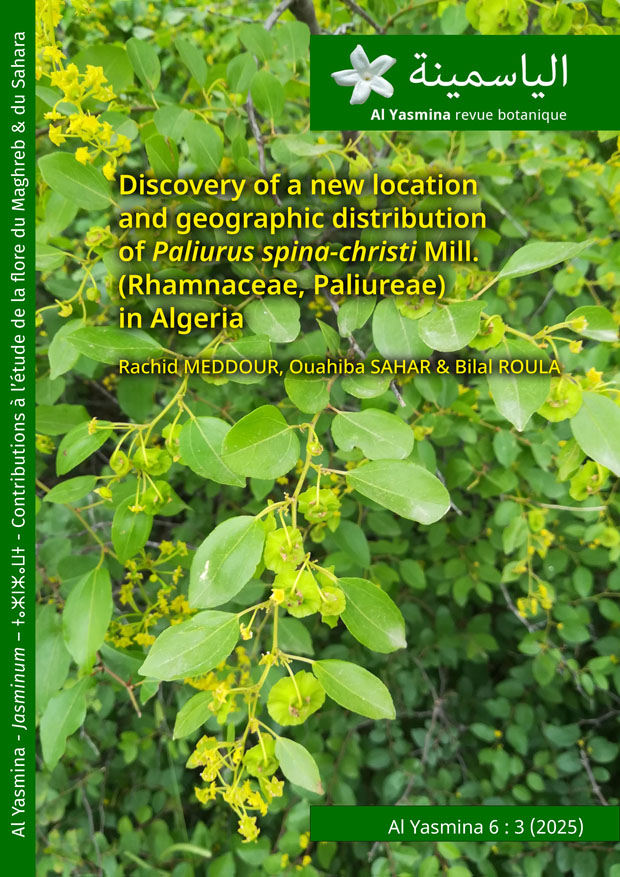
Abstract
There is very little information on Paliurus spina-christi in North Africa. Therefore, the aim of the present study is to provide the geographic distribution of Paliurus spina-christi Mill. in Algeria, with a description of a new location, not previously documented.
Keywords : chorology, North Africa, Rhamnaceae
1. Introduction
The genus Paliurus Mill. belongs to the Rhamnaceae, an almost cosmopolitan family of 55 genera and about 950 species (Negash, 2021). It is composed of five species (including four from Eastern Asia) : P. hemsleyanus Rehder ex. Schirarend & Olabi, P. hirsutus Hemsl., P. orientalis (Franch.) Hemsl., P. ramosissimus (Lour.) Poir., and P. spina-christi Mill. (Dong, 2015). In North Africa, it is represented by a single species,P. spina-christi, (synonyms : P. aculeatus (Lam.) Lam., P. australis Gaertn., nom. illeg.) (Dobignard and Chatelain, 2013). Its vernacular names are : sédr, zegregh, ennab, corna (in arab), abaga, labacat (in temahac), and magaria, cussulu (in Algeria) (De Natale and Pollio, 2012).
2. Botanical description
Some characteristics taken from Castroviejo et al. (2015). It is a deciduous shrub species or a small tree, 2-3(5) m. Branches somewhat pendulous, pubescent when young. Leaves with leaf blade limbo 20-40 × 14-30 mm, puberulous, glabrescent, green on the upper side, paler on the underside ; petiole 4-10 mm, puberulous, glabrescent ; stipules 2, transformed into spines, the longest ± straight ; the other curved, persistent. Bracts 0.6-1.1 mm, hairy or glabrous, usually with glandulous margin, brown, promptly caducous. Flowers pentamerous (rarely hexamerous). Receptacle patelliform, glabrous ; pedicel accrescent when fruiting (up to 12 mm). Sepals 1.5-1.8x1.2-1.5 mm, glabrous, yellow-greenish. Petals 1-1.6x0.6-1.1 mm, white-yellowish. Fruit 19-26 mm in diameter (including the wing), with wing inserted in the middle, wide, entire to irregularly crenulate, glabrous. Seeds 4,2-4,7x3,9-4,3 mm. 2n=24. Flowering : April to July. Fruiting : May to September. This species should not be confused especially with Ziziphus spina-christi (L.) Desf., which looks like but has an edible fleshy fruit (Lapie and Maige, 1914).
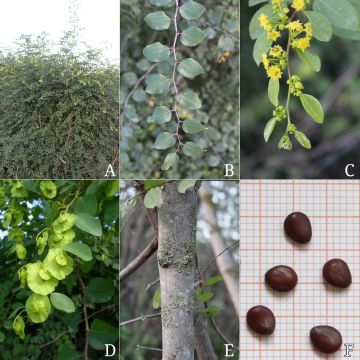
3. Global native distribution and area of introduction
The native range of this species extends from northern Mediterranean Basin (S. and E. Europe) to Central Asia and NW Aghanistan (Pausas, 2011) : North Spain, S France, Italy, Greece (East Aegean Is.), Turkey, North Macedonia, Croatia, Albania, Lebanon, Syria, Palestine, Bulgaria, Romania, Georgia, Ukraine, Russian Federation, Krym/Crimea, North Caucasus, Transcaucasus, Tadzhikistan, Turkmenistan, Uzbekistan, Iran, Iraq, Afghanistan (POWO, 2024), and recorded as introduced in Texas-USA, Belgium, Corsica, Hungary and Cyprus (GBIF secretariat, 2024).
In the southern Mediterranean Basin, the distribution in the Northern Africa appears somewhat doubtfully native and is surely subspontaneous (Schirarend and Olabi, 1994). The species is introduced in Algeria (Dobignard and Chatelain, 2013 ; POWO, 2024), Libya (Gawhari et al., 2018), and Tunisia (Le Floc’h et al., 2010). However, the status of the species is problematic (Dobignard and Chatelain, 2013 ; APD, 2024), and it is even considered as native by Euro+Med PlantBase (2024) (Fig. 1).
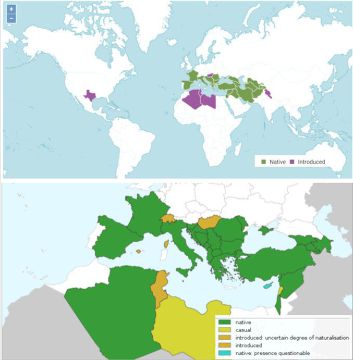
4. Distribution in Algeria
Of ancient introduction since already cited by Desfontaines (1798-1799), “in Atlante et in collibus incultis” (in the Atlas and in the uncultivated hills), the species was initially reported as “quite rare in Algeria”by Mathieu (1860), but without precision of its native or non-native status. Then the species was reported as cultivated for hedges, casual (subspontaneous) in the sites where it is cultivated (Battandier and Trabut, 1905 ; Lapie and Maige, 1914). The species was reported in several historical locations, viz. in Ben Aknoun and Miliana (Battandier and Trabut, 1888-1890), in the vicinity of the ‘Pépinière’ in Constantine (Julien, 1894), in the Sahel of Mitidja (Ducellier and Maire, 1923), and in the surroundings of Algiers and Mahelma (Quézel and Santa, 1963), where these authors question its native status. Afterwards, it was recorded in Jebel Bouzegza (Wojterski, 1988), and in Oued Bou Sellam at Setif, where it was given as naturalised in the waterside elm forest, near ‘Fort Fontaine Bougra’ (Kaabèche et al., 1995) (Table 1).
Nowadays, the species is observed in Jebel Ouahch near Constantine, in 2015 by A.D. Filali (where it has become naturalised and extends over a site of 19 hectares), in the vicinity of Constantine, in 2022 by M. Chetibi, and at Mechroha near Souk Ahras, by De Bélair in 2016. It is also cultivated in the Botanical Garden of Hamma, Algiers (JBH, 2013).

| Locations | References |
|---|---|
| Cultivated as hedges and often subspontaneous in Ben Aknoun, Miliana, etc. | Battandier and Trabut (1888-1890) |
| Cultivated as hedges and subspontaneous in the vicinity of the Pépinière in Constantine. | Julien (1894) |
| Cultivated as hedges in the Sahel, Mitidja, Miliana, rarely subspontaneous. | Ducellier and Maire (1923) |
| Cited around Algiers, Mahelma, Miliana. | Quézel and Santa (1963) |
| Reported on the Jebel Bouzegza (Tellian Atlas) in 1984. | Wojterski (1988) |
| Reported in Bou Sellam wadi valley, at Sétif, where it is naturalised. | Kaabèche et al. (1995) |
| Observed at Mechroha, Souk Ahras, 36.4 N and 7.8 E, by G. De Bélair, 2016-05-27. | Herbier GdB, https://gdebelair.com/imascan/119_23.jpg |
| Observed at Jebel Ouahch, Constantine, 36.4 N and 6.6 E in 2015-08-09 by A.D. Filali | iNaturalist.org, https://www.inaturalist.org/observations/16256926 |
| Observed near Constantine, 36.2 N and 6.6 E, 2022-02-04, by M. Chetibi. | iNaturalist.org, https://www.inaturalist.org/observations/106128604 |
5. Context of the new location
During our visit to the forests of Jijel province, attracted by its ornamental character, Paliurus spina-christi was discovered in June 11, 2019 in the place called Chaddia, in the Kaous municipality, a new location (Figs. 2-3). The discovery site (Kaous municipality) is located in the northeastern part of Algeria, about 8 km southeast from the city of Jijel. The site is an open field, delimited by a hedgerow of Paliurus spina-christi, constituted with a group of shrubs of ca. 2 m in height, occupying an area of 1400 m² (200 m long by 7 m wide), on the roadside of the department road 153 (Fig. 4). The site is at the following GPS point : 36°45’06.9" N and 5°49’12.9" E, and at an elevation of 74 m a.s.l. The substrate is siliceous (Numidian sandstones) marked by a flat microrelief, where the slope is less than 5°. It is one of the wettest areas of the country, with an average of 800 to 1200 mm of rainfall per year, but the climate remains Mediterranean with a dry summer (Bounar et al., 2021).
This first visit and a second, on November 03, 2024, allowed us to observe several individuals, growing in groups, with fully developed foliage, in full bloom, fruiting, and in good growing conditions (Fig. 5). This thicket is certainly of non-native status, but it reproduces by suckers. Voucher specimen of the plant is deposited in the herbarium of the national institute of forest research (INRF) of Jijel.
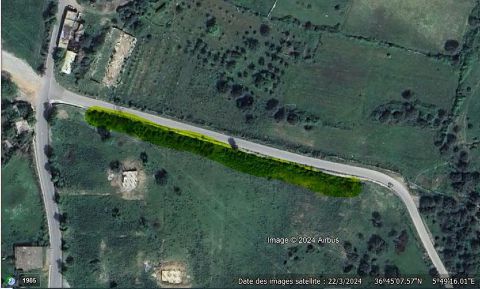
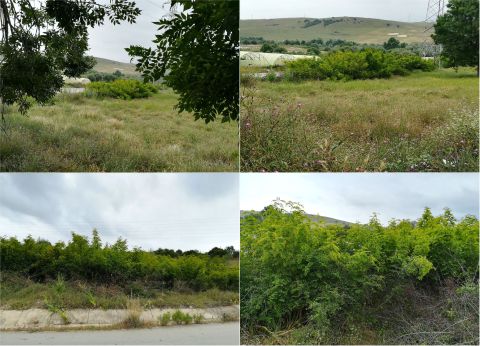
6. Uses and motives of introduction
Paliurus spina-christi is an ornamental plant, which in the Mediterranean area has a long history of use as defensive hedges. Its many thorns make it very suitable for making good hedges (Mathieu, 1860). In general, it can be planted in uncultivated and arid soils, particularly calcareous, for the creation of defensive hedges, for erosion control purposes and to form stock-prof living fences in arid areas (Ali and Jafri, 1977).
In Mediterranean region, it is a well-known medicinal plant (Brantner and Males, 1990), and are widely used for different medical purposes, for example, in Turkey (Zor et al., 2017). In herbal medicine, dried or raw fruits are used as an infusion for diuretic and tonic properties (UNESCO, 1960). The roots, branches and leaves of Paliurus were once used as astringents and the fruits, which contain flavonoids (rutin), as hypertensives to "lower blood pressure" (Castroviejo et al., 2015). In addition, in North Africa, its young shoots and leaves are used as a dewormer in Libya (De Natale and Pollio, 2012). However, in Algeria and Tunisia, there is no information about its medicinal uses.
7. Conclusion
We can conclude that Paliurus spina-christi is currently present in several locations of the northeastern Algeria (Kaous, Constantine, Jebel Ouahch, Mechroha, Bou Sellam, Bou Zegza) and other historical locations in Algiers region (Miliana, Mahelma, Ben Aknoun). The species is to be investigated in priority in its historical sites of the Algiers area, and in potential new sites, likely to contain this plant species. It is in particular lacking in the northwestern part of Algeria, under semi-arid and arid conditions, where it can be planted in roadsides, forest edges and clearings, uncultivated and arid soils, particularly calcareous, for the establishment of protective hedges and windbreaks for erosion control purposes.
Acknowledgments
The authors wish to thank the INRF regional technical staff of Jijel for having kindly provided the information about this location.
Conflicts of interest
The authors declare no conflict of interest.
References
Ali, S. I. and Jafri, S. M. H. (eds) (1977)Flora of Libya. University Al Faateh. Tripoli.
APD 2024 : African Plant Database. https://africanplantdatabase.ch [accessed 08/09/2024].
Battandier, J. A. and Trabut, M. (1888-1890)Flore de l’Algérie.Ancienne Flore d’Alger transformée. Contenant la description de toutes les plantes signalées jusqu’à ce jour comme spontanées en Algérie. Alger & Paris.
Battandier, J. A. and Trabut, M. (1905)Flore analytique et synoptique de l’Algérie et de la Tunisie. Alger.
Bounar, R., Charmat, S., Ghemmam Amara, D. and Adjabi, A. (2021) Analysis of species floristics within the oak forests of Guerrouche (Jijel, Algeria). Environmental and socioeconomic studies, 9 : 3-17. https://doi.org/10.2478/environ-2021-0013
Brantner, A. and Males, Z. (1990) Investigations on the Flavonoid Glycosides of Paliurus spina-christi. Planta Med., 56(6) :582-583. https://doi.org/10.1055/s-2006-961187
Castroviejo, S., Munoz Garmendia, F., Navarro, C., Quintanar, A. and Buira, A. (eds) (2015) Flora Iberica. Plantas vasculares de la Peninsula Iberica e Islas Baleares. Madrid.
GDB (2024) Gérard De Bélair herbarium. https://gdebelair.com/imascan/119_23.jpg [accessed 08/09/2024].
De Natale, A. and Pollio, A. (2012) A forgotten Collection : The Libyan Ethnobotanical exhibits (1912-14) by A. Trotter at the Museum O. Comes at the University Federico II of Naples, Italy. Journal of Ethnobiology and Ethnomedicine, 8 : 4. https://doi.org/10.1186/1746-4269-8-4
Desfontaines, R. L. (1798-1799) Flora Atlantica, sive Historia Plantarum, quae in Atlante, Agro tunetano et algeriensi crescunt. Paris.
Dobignard, A. and Chatelain, C. (2013)Index Synonymique de la Flore d’Afrique du Nord. Genève.
Dong, J. L., Sun, B. N., Ma, F. J., Wang, Q. J., Jin, P. H., Wang, W. J., Deng, P., Yang, Y. and Li, X. J. (2015) Paliurus Fruits from the Oligocene of South China and Their Phytogeographic Implications. PLoS ONE, 10(11) : e0140653. https://doi.org/10.1371/journal.pone.0140653
Ducellier, L. and Maire, R. (1923) Végétaux adventices observés dans l’Afrique du Nord. Bull. Soc. Hist. Nat. Afr. N., 14 : 304–325.
Euro+Med PlantBase (2024) Euro+Med PlantBase. The Information Resource for Euro-Mediterranean Plant Diversity. http://ww2.bgbm.org/EuroPlusMed/ [accessed 08/09/2024].
Gawhari, A. M. H., Jury, S. L. and Culham, A. (2018)Towards an updated checklist of the Libyan flora. Phytotaxa, 338(1) : 1-16. https://doi.org/10.11646/phytotaxa.338.1.1
GBIF secretariat (2024) GBIF Backbone Taxonomy. https://www.gbif.org/species/7273634 [accessed 26/09/2024].
iNaturalist (2024) A Community for Naturalists. https://www.inaturalist.org/observations/16256926 [accessed 26/09/2024].
IUCN (2024) The IUCN Red List of threatened species. https://www.iucn redlist.org [accessed 26/09/2024].
JBH (2013) Index seminum 2012-2013. Jardin Botanique du Hamma. Alger.
Julien, A. (1894) Flore de la région de Constantine. Constantine.
Kaabèche, M., Gharzouli, R. and Géhu, J. M. (1995) Phytosociologie et typologie des habitats de la haute vallée de l’oued Bou-Sellam (Sétif, Algérie). Colloques phytosociologiques, 23 : 531-557.
Lapie, G. and Maige, A. (1914) Flore forestière illustrée, comprenant toutes les espèces ligneuses de l'Algérie et les espèces ligneuses les plus répandues en Tunisie, au Maroc et dans le midi de la France. Paris.
Le Floc’h, E., Boulos, L. and Vela, E. (2010) Catalogue synonymique commenté de la Flore de Tunisie. République Tunisienne.
Mathieu, A. (1860) Flore forestière. Description et histoire des végétaux ligneux qui croissent spontanément en France et des essences importantes de l’Algérie. Nancy, Paris.
Negash, L. (2021) A Selection of African Native Trees : Biology, Uses, Propagation and Restoration Techniques. Addis Ababa.
Pausas J. (2011) MedTrees : trees and large shrubs of the Mediterranean Basin. https://www.uv.es/jgpausas/medtrees/MedTrees.html [accessed 08/09/2024].
POWO (2024) Plants of the World Online. http://www.plantsoftheworldonline.org/ [accessed 08/09/2024].
Quézel, P. and Santa, S. (1963)Nouvelle Flore de l’Algérie et des régions désertiques méridionales.París.
Schirarend, C. and Olabi, M. N. (1994) Revision of the genus Paliurus Tourn. ex Mill. (Rhamnaceae). Bot. Jahrb. Syst., 116(3) : 333-359.
UNESCO (1960) Medicinal plants of the arid regions. Arid zone research XIII. Paris.
Wojterski, T. W. (1988) Guide de l’excursion internationale de phytosociologie. El Harrach, Göttingen.
Zor, M., Aydin, S., Güner, N. D., Başaran, N. and Başaran, A. A. (2017) Antigenotoxic properties of Paliurus spina-christi Mill fruits and their active compounds. BMC Complement. Altern. Med., 17(1) : 229. https://doi.org/10.1186/s12906-017-1732-1